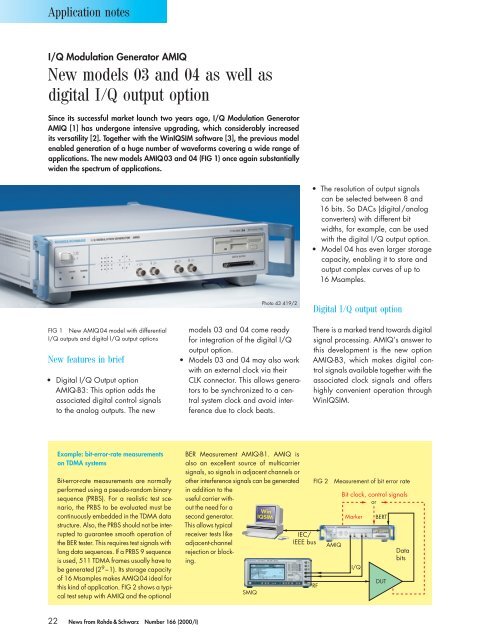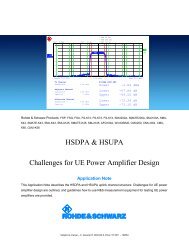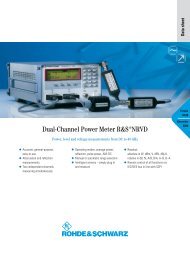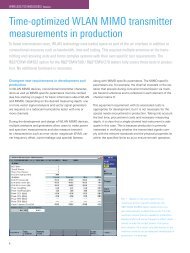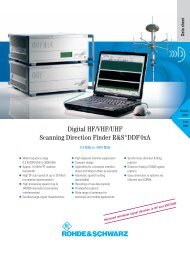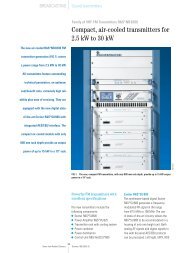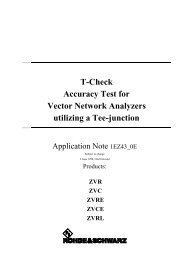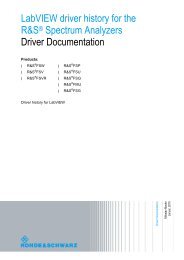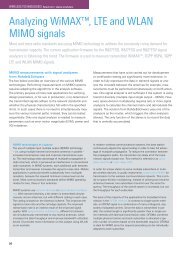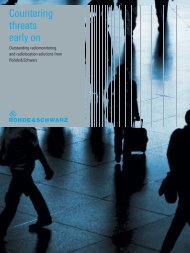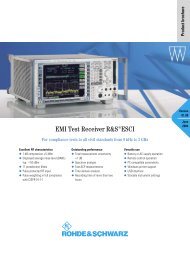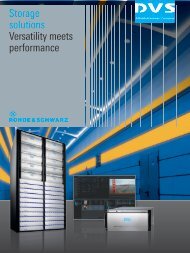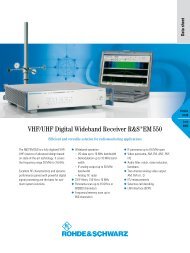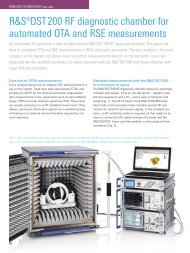English - Rohde & Schwarz
English - Rohde & Schwarz
English - Rohde & Schwarz
Create successful ePaper yourself
Turn your PDF publications into a flip-book with our unique Google optimized e-Paper software.
Application notes<br />
I/Q Modulation Generator AMIQ<br />
New models 03 and 04 as well as<br />
digital I/Q output option<br />
Since its successful market launch two years ago, I/Q Modulation Generator<br />
AMIQ [1] has undergone intensive upgrading, which considerably increased<br />
its versatility [2]. Together with the WinIQSIM software [3], the previous model<br />
enabled generation of a huge number of waveforms covering a wide range of<br />
applications. The new models AMIQ03 and 04 (FIG 1) once again substantially<br />
widen the spectrum of applications.<br />
FIG 1 New AMIQ04 model with differential<br />
I/Q outputs and digital I/Q output options<br />
New features in brief<br />
• Digital I/Q Output option<br />
AMIQ-B3: This option adds the<br />
associated digital control signals<br />
to the analog outputs. The new<br />
Example: bit-error-rate measurements<br />
on TDMA systems<br />
Bit-error-rate measurements are normally<br />
performed using a pseudo-random binary<br />
sequence (PRBS). For a realistic test scenario,<br />
the PRBS to be evaluated must be<br />
continuously embedded in the TDMA data<br />
structure. Also, the PRBS should not be interrupted<br />
to guarantee smooth operation of<br />
the BER tester. This requires test signals with<br />
long data sequences. If a PRBS 9 sequence<br />
is used, 511 TDMA frames usually have to<br />
be generated (2 9 –1). Its storage capacity<br />
of 16 Msamples makes AMIQ04 ideal for<br />
this kind of application. FIG 2 shows a typical<br />
test setup with AMIQ and the optional<br />
22 News from <strong>Rohde</strong> & <strong>Schwarz</strong> Number 166 (2000/I)<br />
models 03 and 04 come ready<br />
for integration of the digital I/Q<br />
output option.<br />
• Models 03 and 04 may also work<br />
with an external clock via their<br />
CLK connector. This allows generators<br />
to be synchronized to a central<br />
system clock and avoid interference<br />
due to clock beats.<br />
BER Measurement AMIQ-B1. AMIQ is<br />
also an excellent source of multicarrier<br />
signals, so signals in adjacent channels or<br />
other interference signals can be generated<br />
in addition to the<br />
useful carrier with-<br />
out the need for a<br />
second generator.<br />
This allows typical<br />
receiver tests like<br />
adjacent-channel<br />
rejection or blocking.<br />
SMIQ<br />
Photo 43 419/2<br />
Win<br />
IQSIM<br />
IEC/<br />
IEEE bus<br />
• The resolution of output signals<br />
can be selected between 8 and<br />
16 bits. So DACs (digital/analog<br />
converters) with different bit<br />
widths, for example, can be used<br />
with the digital I/Q output option.<br />
• Model 04 has even larger storage<br />
capacity, enabling it to store and<br />
output complex curves of up to<br />
16 Msamples.<br />
Digital I/Q output option<br />
There is a marked trend towards digital<br />
signal processing. AMIQ’s answer to<br />
this development is the new option<br />
AMIQ-B3, which makes digital control<br />
signals available together with the<br />
associated clock signals and offers<br />
highly convenient operation through<br />
WinIQSIM.<br />
FIG 2 Measurement of bit error rate<br />
RF<br />
AMIQ<br />
Bit clock, control signals<br />
or<br />
Marker<br />
I/Q<br />
BERT<br />
DUT<br />
Data<br />
bits


